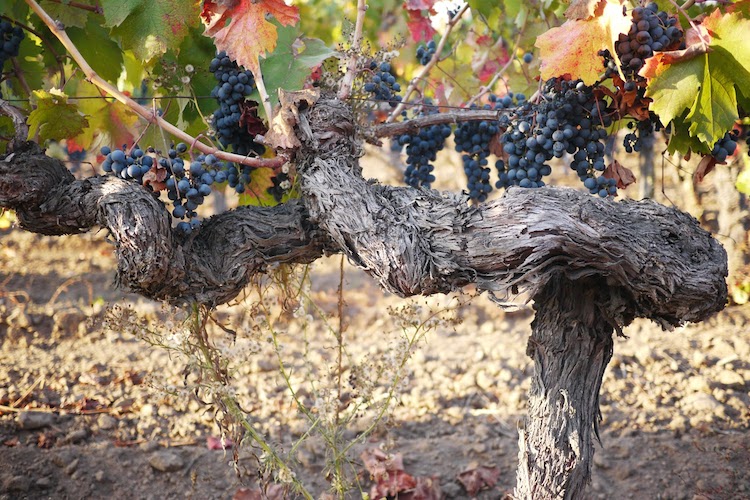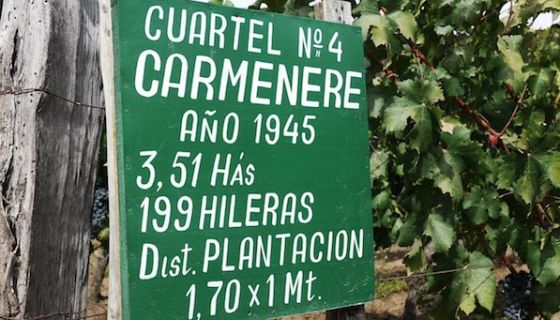From $17.99, 14,990 Chilean pesos, €19.98, £19.95, 119.90 Brazilian reais
It may seem a bit perverse not to be choosing a French wine on Bastille Day but at least the grape is French, even if it is much more widely planted in Chile than in France today.
Carmenère, as wine students know, is an old Bordeaux variety closely related to both Cabernet Sauvignon and Merlot that was widely planted before the phylloxera louse had crossed the Atlantic from North America but largely abandoned afterwards in south-west France (although it does constitute a tiny proportion of the encépagement of Ch Clerc Milon in Pauillac) because it yielded irregularly there. But it was taken to Chile, along with other Bordeaux varieties, in the mid nineteenth century, before phylloxera had arrived.
Few people had heard of it until the mid 1990s when French ampelographer Jean-Michel Boursiquot of Montpellier visited Chile and realised that many – indeed most – of the vines the locals called Merlot were in fact Carmenère. This led to a period when Chilean vines tended to be distinguished as ‘Merlot’ and ‘real Merlot’ but since then plantings of real Merlot have increased significantly (so that a Chilean wine labelled Merlot really will be made of Merlot) and one faction of the Chilean wine industry has sought to celebrate the Carmenère planted as a national point of difference.
The thinking was that, around the turn of the century at least, many successful wine-exporting countries were associated with a single variety: New Zealand with Sauvignon Blanc, Australia with Shiraz and, most significantly for their rivals on the other side of the Andes, Argentina with Malbec. But I hope that that project has been abandoned as in my view Carmenère is generally better in a blend than as a 100% varietal wine. It can be quite difficult to get it fully physiologically ripe, even in a climate as warm as Chile’s, and too many lesser examples have a certain greenness.

But this example is exceptional. As the name suggests, the vines were planted in 1945, so are a fine old age, and the vineyard, rather than being planted with a single clone as is the norm nowadays, is populated by a rich array of different genetic material. Purple Pagers can read all about mass selection (sélection massale in French) in their online Oxford Companion to Wine. You can generally see how old the vines are by the thickness of the trunks. The vines grow so irregularly that the vineyard has to be ploughed by horses rather than by tractors. Our unique global old vines register on Purple Pages may well be of interest. Feel free to contact us via the Contact form with suggested omissions.
The estate, 70 miles south west of Santiago, on which Clos de Luz is planted was bought by Gabriel Edwards’ great grandfather in 1892 and vines were first planted by his grandmother Luz in 1945. Presumably it was rather unusual at that time to have a woman in charge of a wine operation.
It’s located in the valley of Almahue, known as Carmenère Central in Chile as it is where most of the oldest plants are to be found; the vines from which this wine comes may well be the oldest Carmenère in the world. About three-quarters of Clos de Luz is planted with this variety, and presumably yields are far lower than the Chilean norm. Massal 1945 contains about 15% Syrah. The fruit of the vines used to be sold to Casa Lapostolle in Apalta to the south west. This French company’s ‘Merlot’ was a massive hit in the 1990s.

Clos de Luz, Massal 1945 Carmenère 2015 Rapel is fermented with indigenous yeast and aged for a year in French oak of varying ages. Gabriel Edwards has a masters in wine business from Burgundy and has worked for both the estimable Undurraga and Moët & Chandon so presumably has a fairly cosmopolitan view of wine.
I was struck by the sweet, welcoming fruit of this wine with only the merest hint of the tomato flavours that characterise many a Carmenère (known as Cabernet Gernischt in China, incidentally). It is unlike most of its peers for having such integrity and interest. I appreciated both its natural freshness (nights here can be quite cool since the Andes are not too far away) and the roundness of its appeal. Thanks to its lightly assertive tannins on the finish, it should continue to evolve for another four years or so, I think.
Drink this with food. Marinated duck breast and Kobe beef(!) are recommended by the producer.
Although fewer than 3,000 cases were made, the wine is reasonably widely available in the US and also in South America. In the UK it is imported by Laytons and available from their retail arm Jeroboams, either in their shops around London at £19.95 or £17.96 as part of a mixed case from their website. The new site is not yet live but in the meantime you can order by emailing enquiries@jeroboams.co.uk.













